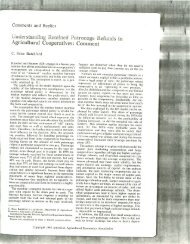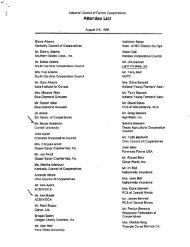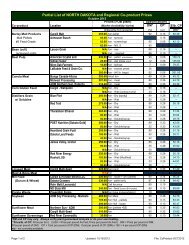Sunflower Production Field Guide - Your "Home Page"
Sunflower Production Field Guide - Your "Home Page"
Sunflower Production Field Guide - Your "Home Page"
You also want an ePaper? Increase the reach of your titles
YUMPU automatically turns print PDFs into web optimized ePapers that Google loves.
18<br />
Tillage, Seedbed Preparation<br />
and Planting<br />
(Roger Ashley and Don Tanaka)<br />
Sunfl ower, like other crops, requires proper seedbed<br />
conditions for optimum plant establishment. Errors<br />
made at planting time may be compounded throughout<br />
the growing season. Seedbed preparation, soil tilth,<br />
planting date, planting depth, row width, seed distribution<br />
and plant population should be nearly correct as<br />
conditions permit.<br />
Tillage and Seedbed Preparation<br />
Tillage traditionally has been used to control weeds<br />
and incorporate herbicides in preparation for planting.<br />
When tillage is used in low rainfall areas, producers<br />
must take care to control weeds while leaving as much<br />
of the previous crop’s residue intact as possible. Tillage<br />
never should occur when soils are too wet. Soils<br />
that are tilled when too wet and then dry will crust,<br />
turn lumpy and generally provide for poor seedbed<br />
conditions for germination and establishment.<br />
Maintaining a moist seedbed is important if producers<br />
expect to have uniform germination and emergence<br />
across the fi eld (Figure 10). Poor germination<br />
and emergence will infl uence the need for and the<br />
effectiveness of future management practices. Excessive<br />
tillage should be avoided where tillage is used<br />
to prepare the seedbed or to incorporate preplant<br />
herbicides. Excessive tillage will break down soil<br />
structure, cause compaction and crusting problems,<br />
reduce aeration, restrict water movement and provide<br />
■ Figure 10. No-till one pass seeding systems<br />
preserve soil moisture and ground cover when water<br />
is limited. (Roger Ashley)<br />
conditions favorable for infection by downy mildew or<br />
other soil-borne diseases. Breakdown of soil structure<br />
also causes reduced nutrient and water uptake and<br />
reduces yield.<br />
Tillage and planting equipment is available to provide<br />
systems with varying levels of surface residue for<br />
sunfl ower production. <strong>Production</strong> systems can range<br />
from conventional-till, where the quantity of surface<br />
residue covers less than 30 percent of the soil surface,<br />
to no-till, where the quantity of surface residue covers<br />
more than 60 percent of the soil surface.<br />
Conventional-till <strong>Production</strong> Systems<br />
Conventional-till production systems usually involve<br />
two or more tillage operations for weed control, incorporation<br />
of pre-emergence herbicides and incorporation<br />
of the previous crops residues. Pre-emergence<br />
herbicides may be incorporated with a tandem disk,<br />
chisel or sweep plows, disk harrow, long-tine harrow,<br />
rolling harrow or air seeders with sweeps in different<br />
sequences or combinations. Tillage sequences are<br />
determined by herbicide label requirements by the<br />
quantity of crop residue present at the beginning of<br />
the tillage operation, and by the seedbed requirements<br />
needed to match planting equipment capabilities.<br />
Conventional tillage systems, with or without preemergence<br />
or post-emergence herbicide, may include<br />
the option of row cultivation once or twice during the<br />
early growing season before the sunfl ower reaches a<br />
height too tall for cultivation. A rotary hoe or harrow<br />
can be used just before sunfl ower emergence and/or at<br />
the V-4 to V-6 development stage. Harrowing or rotary<br />
hoeing between emergence and the V-4 stage can result<br />
in injury or death of the sunfl ower plant. Depending<br />
on planting depth and stage of crop development,<br />
stand losses are generally less than 5 percent if the<br />
sunfl ower crop has at least two fully expanded leaves.<br />
Proper adjustment of the harrow or rotary hoe will<br />
maximize damage to the weeds and minimize injury<br />
to the sunfl ower crop.<br />
Minimum-till <strong>Production</strong> Systems<br />
Minimum-till production systems use subsurface<br />
implements with wide sweeps, such as an undercutter<br />
(Figure 11), or harrow systems for application<br />
and incorporation of herbicides. These production<br />
systems leave between 30 percent and 60 percent of<br />
the soil surface covered by crop residue after planting.<br />
Minimum-tillage sunfl ower production systems rely







